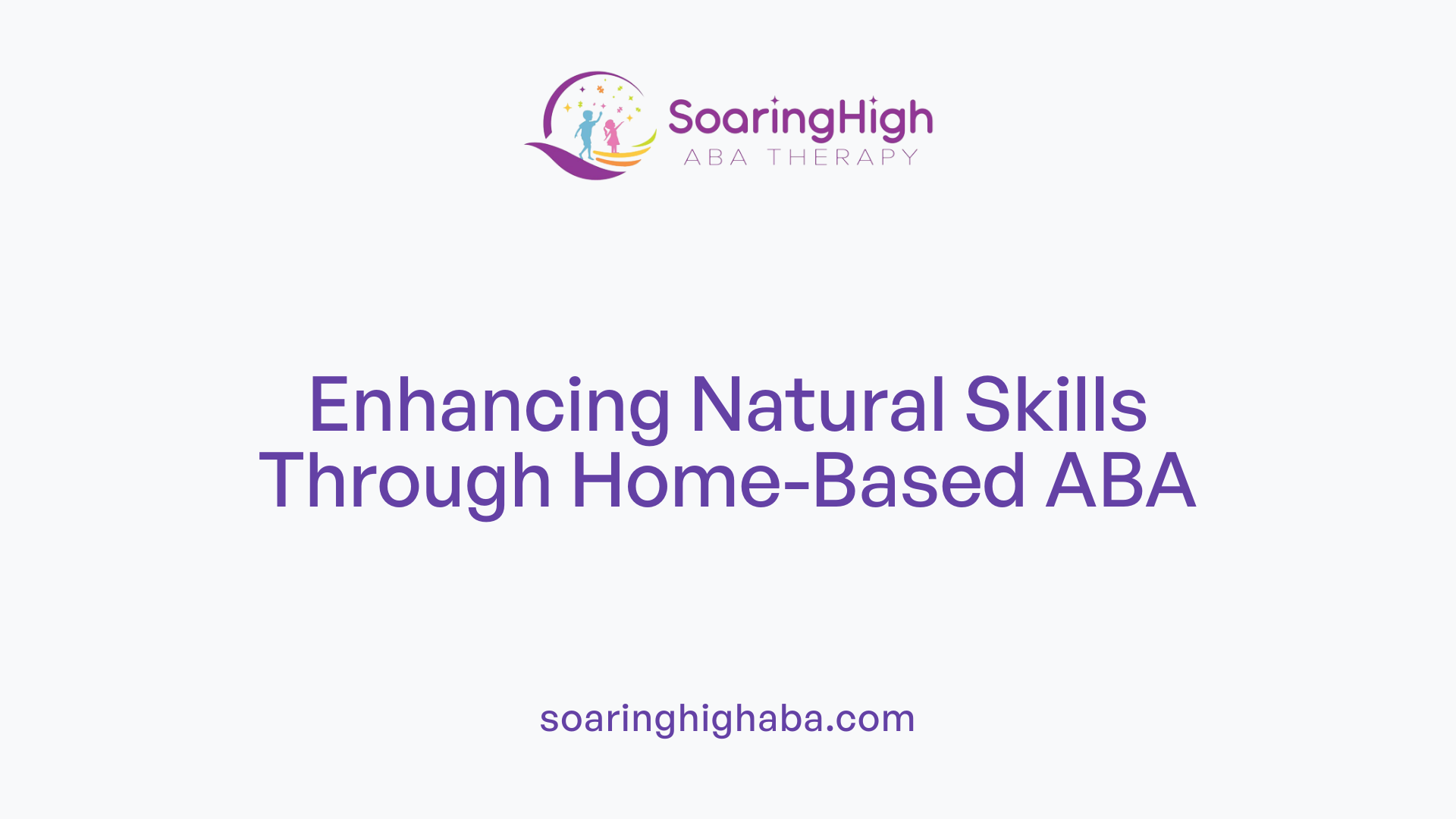Unlocking the Power of Family Engagement in ABA Therapy
Family participation in home-based ABA therapy is a cornerstone of effective intervention for children with autism. When families actively engage, it not only enhances skill acquisition but also fosters stronger bonds, promotes generalization of learned behaviors, and creates a more supportive environment for lasting growth. This article explores the myriad benefits of family involvement, strategies for effective participation, and how to make the most of home-based ABA therapy.
Personalized and Contextualized Interventions Boost Effectiveness

How does home-based ABA therapy facilitate the development of individualized treatment plans?
Home-based ABA therapy allows trained therapists to conduct comprehensive assessments in the familiar environment of the child's home. This setting provides crucial insights into the child's natural behaviors, routines, and interactions, which are instrumental in creating customized treatment plans. By observing how the child responds to everyday situations, therapists can identify specific needs, interests, and strengths. This information enables the formulation of tailored strategies that are practical and relevant to the child's daily life, ensuring that interventions are directly applicable and effective.
Moreover, ongoing in-home assessments facilitate continuous adjustments to the therapy plan. As the child develops and responds to interventions, therapists can modify activities and goals to match evolving needs, promoting steady progress.
Use of the child's natural environment to make learning more relevant
Utilizing the child's home as the learning environment ensures that therapy is rooted in real-life contexts. Incorporating everyday items like kitchen utensils, toys, or clothing helps children connect skills learned during sessions to their daily routines. For example, practicing dressing skills with clothes from the child's wardrobe or cleaning up with their own toys makes skills more meaningful and easier to generalize.
This environment also reduces anxiety by providing a familiar, comfortable space, encouraging children to engage more fully. When activities are relevant to their typical surroundings, children are more motivated to participate, which enhances learning and retention.
Why are activities important for a child undergoing ABA therapy?
Activities are essential in ABA therapy because they provide practical, engaging opportunities for children to learn and practice important skills in meaningful contexts. Through play-based tasks such as social games, storytelling, and sensory activities, children can develop communication, social, and cognitive skills in a way that feels fun and motivating.
These activities also support behavior management by reinforcing positive behaviors and redirecting challenging ones. Additionally, tailored activities help address each child's unique needs and interests, making therapy more effective and personalized.
Overall, incorporating diverse activities promotes progress, generalization of skills, and helps children build independence and confidence.
| Aspect | Benefit | Additional Details |
|---|---|---|
| Individualized plans | Tailored to child's needs | Developed through in-home assessments and continuous monitoring |
| Natural environment use | Relevance and comfort | Utilizes familiar items and routines for better engagement |
| Family involvement | Reinforces skill generalization | Encourages parent participation and practice at home |
| Flexibility in scheduling | Fits into daily life | Ensures therapy adapts to child's mood and family routines |
| Focus on real-life skills | Promotes independence | Includes social skills, daily routines, and communication |
This holistic approach ensures that therapy is not only personalized but also seamlessly integrated into the child's everyday experiences, leading to more meaningful and sustained development.
Creating a Supportive and Structured Home Environment

How can families implement ABA therapy at home?
Implementing ABA therapy at home involves creating a structured environment that fosters learning and development. Families can start by establishing consistent routines throughout the day, such as regular meal times, play periods, and bedtime schedules. Visual supports like visual schedules, choice boards, and timers are essential tools that help children understand daily expectations and transitions, reducing anxiety and promoting independence.
Using positive reinforcement is crucial. Parents should praise or reward desired behaviors immediately to motivate the child and encourage skill mastery. Breaking complex skills into small, manageable steps through task analysis makes learning more accessible. Prompting techniques—such as gestures, words, or physical guidance—can support the child in acquiring new skills, with prompts gradually fading to promote independence.
Collecting data on the child's behaviors and progress enables parents to track improvements and identify areas needing more support. This data-driven approach helps both families and professionals to tailor interventions effectively.
Collaboration with trained professionals like Board Certified Behavior Analysts (BCBAs) ensures that strategies used at home align with the child's overall treatment plan. Incorporating naturalistic teaching strategies, such as practicing skills during play or daily routines, supports the generalization of learned behaviors to real-life situations and across different settings.
Overall, a combination of consistent routines, visual supports, positive reinforcement, and professional guidance creates a nurturing space where children can thrive and develop essential skills for independence and social interaction.
How ABA in the Home Facilitates Natural Skill Development

How does ABA in the home work?
Applied Behavior Analysis (ABA) in the home setting involves applying specific behavioral strategies within the child's natural environment. This approach makes it easier for children to transfer learned skills to real-life situations.
ABA uses techniques based on Operant Conditioning principles, such as prompting, shaping, and task analysis, to teach new behaviors and reinforce positive ones. Therapists conduct assessments like ABC data collection—analyzing Antecedents, Behaviors, and Consequences—to understand what triggers certain behaviors and how to modify them effectively.
Progress tracking is an ongoing process, with data guiding adjustments to the intervention plan. Trained professionals like Board Certified Behavior Analysts (BCBAs) and Registered Behavior Technicians (RBTs) work closely with families to develop personalized strategies.
Parents are actively involved in the process. They learn to implement ABA activities such as using visual cues, reinforcing desired behaviors, and teaching emotional recognition. Their participation helps ensure consistency, leading to better skill acquisition and behavior reduction.
The benefits of home-based ABA extend beyond structured sessions. It fosters natural learning opportunities, with flexible scheduling fitting into daily routines. This environment supports children in developing behavioral, communication, social, and daily living skills, paving the way for greater independence.
Teaching functional skills within familiar environments
Teaching functional skills—like potty training, dressing, preparing meals, and managing time—is essential for a child's independence. The home environment provides a perfect setting to practice these skills because they are directly applicable to everyday life.
In this context, children learn by doing, which enhances retention and skill generalization. Therapists observe how children respond to real-life situations and tailor interventions to incorporate natural routines, making the learning stick.
Advantages of naturalistic teaching methods in daily routines
Naturalistic teaching involves embedding learning into everyday activities. For example, during mealtime, a child might learn requesting skills by using AAC devices or gestures, or during playtime, they might practice social interactions and turn-taking.
This approach leverages the child's interests and motivations, making learning more engaging and less disruptive. It also encourages children to use skills in varied settings, ensuring skills aren’t limited to therapy sessions.
Furthermore, natural routines allow for spontaneous teachable moments, which can be more effective than structured interventions alone. Overall, integrating ABA into daily routines creates a seamless, supportive environment that nurtures growth and independence.
| Aspect | Focus | Benefits |
|---|---|---|
| Functional Skills | Daily routines like potty training, dressing | Promotes independence and real-world application |
| Naturalistic Teaching | Using everyday activities for learning | Engages motivation, enhances generalization |
| Parental Involvement | Training and active participation | Reinforces skills, strengthens family bonds |
| Data-Driven Adjustments | Continuous progress monitoring | Ensures tailored, effective interventions |
This approach ultimately helps children develop essential life skills naturally, making learning both effective and meaningful.
Active parental participation during ABA sessions at home

What can parents do during in-home ABA?
Parents play a vital role in the success of home-based ABA therapy. During sessions, they can create a supportive and distraction-free environment that is tailored to their child's needs. By working closely with the therapist, parents can help set personalized goals that align with their child's interests and strengths.
Reinforcing the behaviors and skills learned during therapy is crucial. Parents can practice these strategies during everyday moments, encouraging fluent use of communication and social skills. For example, using the child’s own toys or routines, like brushing teeth or dressing, helps make learning relevant and practical.
Involving the family in establishing consistent routines, such as mealtime, playtime, and transitions, bolsters skill development and promotes independence. Parents who stay informed and engaged with their child's progress are better equipped to support ongoing improvements. Regular communication with therapists ensures strategies are adapted as needed, creating a cohesive plan that supports the child's growth outside of formal sessions.
Supporting social skills can also be woven into daily interactions, such as engaging with siblings or participating in community activities. This ongoing involvement nurtures social inclusion and emotional resilience, helping children generalize skills in real-life contexts.
Ultimately, active parental participation is about collaboration. It involves planning, practicing, and adapting techniques in daily routines—empowering families and enriching the child's development toward independence.
The Impact of Family Engagement on Therapy Outcomes
What are the benefits of involving family members in ABA therapy?
Family participation plays a crucial role in the success of ABA therapy for children with developmental needs. When family members are actively involved, several positive outcomes emerge, significantly enhancing the child's progress.
One key benefit is improved consistency. Families applying therapeutic strategies across various settings help children generalize skills learned during sessions. This consistency accelerates mastery of important routines, social skills, and communication abilities, making therapy more effective.
Moreover, engaging family members increases collaboration and communication between parents, siblings, and therapists. Such ongoing dialogue ensures interventions are well-tailored and adjustments are made based on the child's evolving needs. This teamwork fosters a unified approach, leading to more cohesive support.
Another advantage is empowering parents and caregivers. Through training and participation, families develop confidence in managing behaviors, reinforcing positive actions, and applying behavioral techniques independently. As a result, parents become active advocates, supporting their child's growth beyond structured sessions.
Overall, involving families in ABA therapy not only boosts skill retention and application but also strengthens family bonds. This holistic approach results in more sustainable, meaningful improvements and fosters a nurturing environment where children can thrive.
Maximizing Benefits Through Education and Collaboration

What are the benefits of involving family members in ABA therapy?
Including family members in ABA therapy can greatly enhance a child's progress and the overall success of the intervention. When family members actively participate, they help ensure that strategies learned during therapy sessions are consistently applied outside of sessions, in everyday situations. This consistency is crucial for skill generalization, making behaviors more likely to stick.
Family involvement also offers valuable opportunities for caregivers to receive training in ABA concepts, positive reinforcement methods, and behavior management techniques. This knowledge enables them to reinforce positive behaviors at home, promote independence, and handle challenging behaviors more effectively. Moreover, involving family members fosters stronger communication and collaboration with therapists. This teamwork ensures that therapy plans are tailored to the child's personal needs and family circumstances.
Beyond skill acquisition, family participation nurtures a sense of empowerment among parents and caregivers. It builds their confidence in supporting their child's development and advocating for their needs. Such family-centered approaches create a more natural, supportive environment for the child and lead to more sustainable, meaningful improvements in behavior, social skills, and daily living activities.
The higher involvement of family members results in faster progress, stronger family bonds, and better overall therapy outcomes. When families are educated and actively engaged, they become essential partners in paving the way for their child's success, making ABA therapy a more enriching and effective experience for everyone involved.
Fostering Family Involvement for Lasting Progress
Active participation of families in home-based ABA therapy is a vital component of effective intervention for children with autism. It leads to faster skill mastery, improved generalization across settings, and stronger emotional bonds within the family. By creating a structured, supportive environment, and collaborating closely with trained professionals, families can maximize the benefits of therapy and foster meaningful, sustainable progress. Emphasizing continuous education, consistent routines, and active engagement, parents and caregivers play a pivotal role in empowering children to reach their full potential and thrive in everyday life.
References
- Home-Based ABA Therapy: Personalized Benefits for Autism
- Impact of ABA Therapy: The Key Role of Parental Involvement
- ABA Therapy at Home: Pros and Cons | Family Hope Solutions
- What are the benefits of in-home ABA therapy? | Autism Resources
- Enhance Family Life with ABA Therapy Services
- What to Expect in ABA Therapy: Activities That Help Kids Thrive
- What to Expect on the First Day of ABA Therapy?
- Exploring ABA Therapy Duration & Timeline | Inclusive ABA
- 5 Benefits of ABA Therapy for Autistic Child
- ABA Therapy at Home: All You Need to Know





































































































